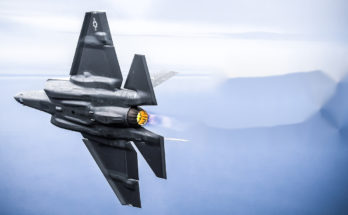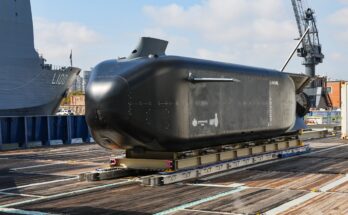By Dan Darling, Forecast International.
Heading down the finishing stretch to Britain’s general election on May 7, the question of what constitutes adequate defense investment has emerged as a thorny political issue.
Thrust into the forefront of electoral issues in recent weeks, questions regarding the state of the British armed forces in the face of ongoing fiscal cutbacks have prompted concerns from Britain’s leading ally, the U.S., as to whether the two militaries will be able to fight side by side in the future. Meanwhile, the U.K. House of Commons Defense Committee just published a report stating that the most recent defense strategy document has become a relic in the face of Russian recidivism and Moscow’s aggressive stance toward Europe.
The British defense budget currently rests at 2 percent of GDP, the NATO Alliance’s non-binding minimum requirement for its members. But it threatens to drop below that level in the coming fiscal year, and – under current spending plans and economic growth assumptions – is in line to fall to 1.7 percent of GDP by 2020-2021.
Under the latest fiscal budget report unveiled by the Treasury, future spending limits will only be protected (i.e., “ring-fenced”) in the cases of international development aid, education and the National Health Service (NHS). Defense, along with all other areas of discretionary expenditure, will therefore be vulnerable to all efficiency spending measures should the next government see fit to follow the deficit-cutting course currently laid out through 2019.
Exacerbating the problem is that defense funding does not sit atop any political party’s agenda, even that of the Conservatives, who currently rule as the majority partner in government with the Liberal Democrats. When defense does emerge as an object of debate, politicians tend to focus on fixed points of symbolism – such as the 2-percent-of-GDP earmark standard – rather than military capability and how it fits into a larger security strategy.
The most recent stab at shaping defense policy, the 2010 Strategic Defense and Security Review (SDSR), offers just such an example.
Unveiled by the Conservative-led government in the fall of 2010, the document drew criticism from many quarters for appearing more concerned with fiscal austerity than grand strategy, and for its imposed equipment cuts.
By temporarily scrapping entire capabilities such as carrier-borne air strike and maritime surveillance, the SDSR drew criticism from military brass for invoking a modern-day “10 Year Rule,” an approach used by the British government in the decade after World War I that called for military planners to draft their budgets under the assumption that Great Britain would not fight a major war within 10 years.
Added to the pressures bearing down on the British military was the government’s fiscal consolidation package aimed at reducing the country’s high budget deficit. As a result of this policy the defense budget was forced to endure a 7.5 percent consolidated spending cut from 2010-2011 through 2014-2015. Further pressure came when successive defense ministers were tasked with trimming an overhang in the defense equipment budget estimated at GBP38 billion ($60 billion) in 2010.
The results have not been pretty.
Today the Royal Navy operates no aircraft carriers and has just 19 combined destroyers and frigates in its fleet.
The British Army is in the process of losing 40 percent of its Challenger main battle tank fleet, 35 percent of its self-propelled heavy artillery pieces, and seeing its numbers shrink from 102,000 to 82,000 troops (a deployable 30,000 reserve element is intended to compensate for this reduction, but recruiting struggles currently present a hurdle).
The Royal Air Force will receive far fewer F-35 Lightning II stealth fighter jets than originally envisioned, while the Ministry of Defense has opted out of a prior commitment toward a final batch of Eurofighter Typhoons (production Tranche 3B).
The government’s “Future Force 2020” structure calls for the Army to have one multirole brigade of about 6,500 soldiers to be the enduring element of its high-readiness capability, meaning a single brigade will be available to operate for an extended period in a theater such as Afghanistan.
In short, this is no longer the British military that provided 46,000 troops to the U.S.-led coalition on the eve of the Iraq invasion in 2003, much less the force that retook the Falkland Islands from a junta-led Argentina in 1982.
The government has been quick to respond to its critics, arguing that it has successfully brought the defense equipment budget into order and in the process committed some GBP160 billion toward military hardware acquisitions through 2022-2023.
Indeed, under current plans the Royal Navy is slated to receive two new 65,000-ton aircraft carriers and a new class of frigates (Type 26) early in the next decade. The Royal Air Force will introduce 22 A400M medium airlifters, three RC‑135W Rivet Joint electronic intelligence (ELINT)-gathering aircraft, and an undetermined number of F-35 combat aircraft, plus drones, into service over the coming 10 years. Added to this, the British Army’s older mechanized land platforms await modernization and/or outright replacement, with the Scout Specialist Vehicle topping the procurement agenda.
Nonetheless, the current spending projections and acquisitions plans may prove vulnerable under the next administration.
Work on a new SDSR will begin in earnest following the election; should the Labour Party head the next government the document likely will not be unveiled until 2016. Regardless of government make-up, the final document’s defining characteristic will undoubtedly take into account the harsh fiscal reality that maintaining the 2-percent-of-GDP standard will cost Britain somewhere in the area of an additional GBP6 billion per year by 2019. With soldiers’ pay, infrastructure improvements, and a decision on replacing the current Trident nuclear deterrent (with an estimated price tag of GBP20 billion) also needing to be factored into the bigger picture, meeting the symbolic benchmark becomes ever costlier.
Maintaining that target becomes all the more expensive due to the fact that the British economy is growing. With economic growth comes the pushing down of the percentage figure, as nominal military allocations are unlikely to rise commensurately with GDP expansion. The flip side, naturally, is that a larger economy means more defense pounds in general, thus rendering the 2 percent standard an arbitrary figure.
Nonetheless, it remains a powerful symbol both to the military, pro-defense politicians and Britain’s allies. In particular, the matter is a politically sensitive one for Prime Minister David Cameron after he exhorted fellow NATO members to heed the minimum defense investment standard at the Alliance summit last year in Wales.
That, of course, illustrates the dilemma facing British defense planners and how the issue of military funding traverses the landscape of guns-versus-butter sociopolitical preferences, and extends to soft- versus hard-power strategic prioritization.
Is a symbolic figure more important than being able find the right funding level to balance equipment and troop requirements? Will defense strategy remain secondary to credit rating concerns? More importantly perhaps, should the international aid allocation be considered in need of greater protection from the budget-cutters than defense?
Certainly, British allies such as France and the U.S. will be eying the next SDSR to see how those questions are answered.
For 50 years, Forecast International intelligence reports have been the aerospace and defense industry standard for accurate research, analysis, and projections. Our experienced analysts compile, evaluate, and present accurate data for decision makers. FI's market research reports offer concise analysis of individual programs and identify market opportunities. Each report includes a program overview, detailed statistics, recent developments and a competitive analysis, culminating in production forecasts spanning 10 or 15 years. Let our market intelligence reports be a key part of reducing uncertainties and mastering your specific market and its growth potential. Find out more at www.forecastinternational.com



